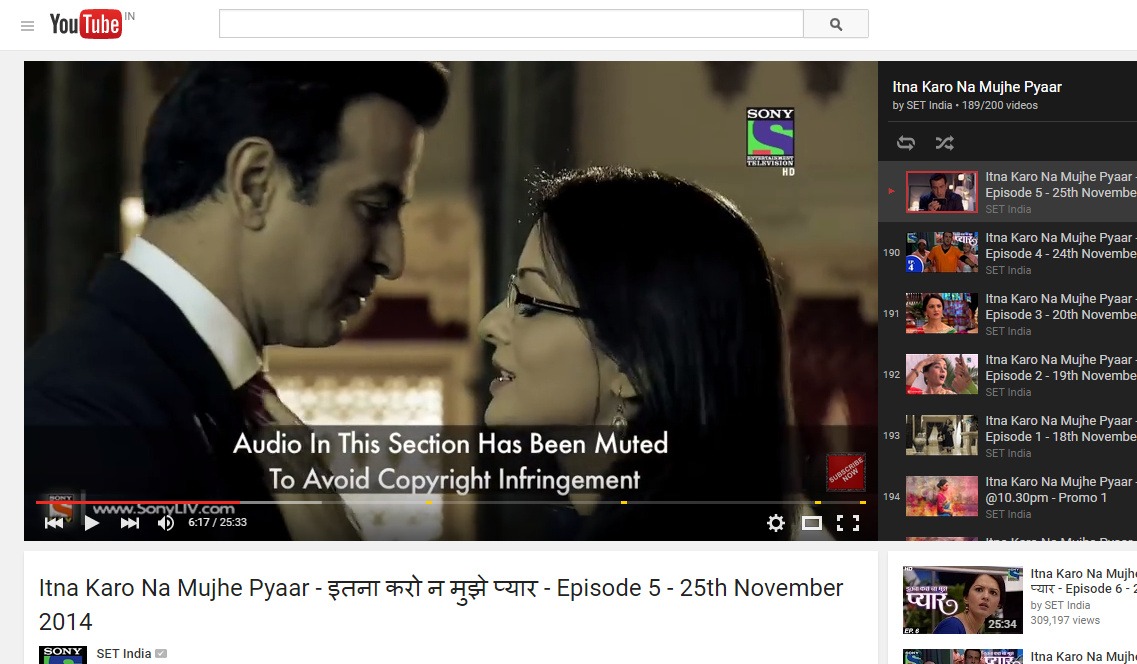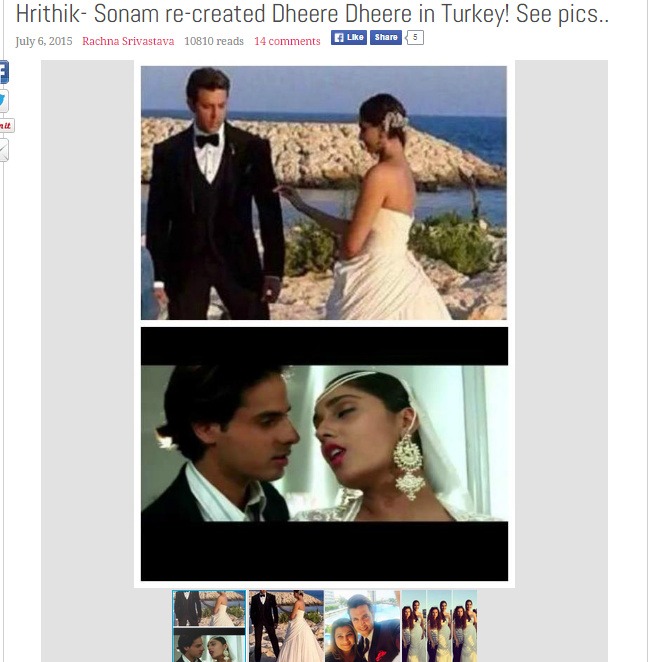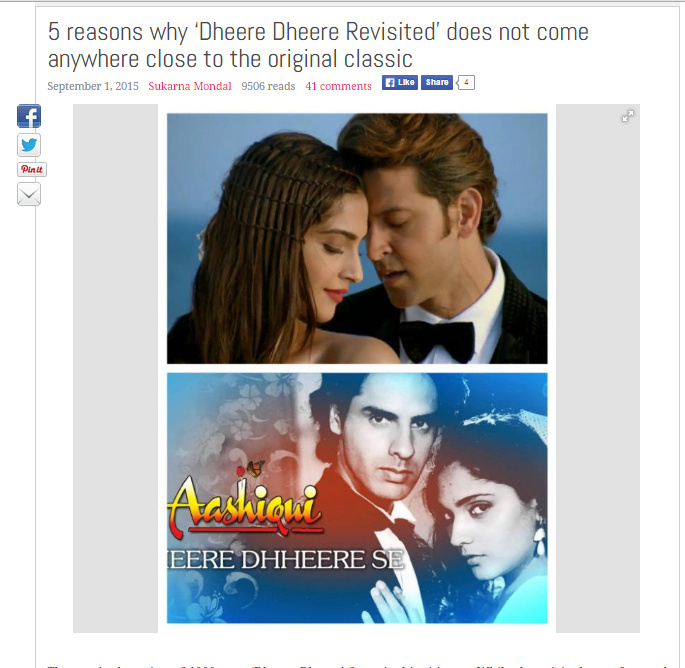This is the fourth and final research note from Abhija Ghosh, one of the short-term social media research fellows at The Sarai Programme.
“I’m a child of the nineties. An era when Rahul Roy was the country’s biggest superstar for a while…I’ve also lived through a time when the average person’s only contact with the outside universe was through newspapers, the radio and one channel on the telly- a channel that you couldn’t even watch unless you went to your balcony and repositioned its antenna every now and then.”[1]
The above quote is from the introduction to 42 Lessons I Learnt from Bollywood : The Vigil Idiot’s Guide to the 1990s, a book that presents a commonsensical, humorous critique of forty two Hindi films from the nineties, in an amateur comic art form, which is more popularly known on the internet as the film review blog, The Vigil Idiot[2]. The blog is embedded in the online cinephile cultures of crisp, self reflexive humor and spoof reviews of popular Bollywood films yet presents the cultural signifiers of the nineties decade with a curious tinge of nostalgia and personal affiliation. Sahil Rizwan, the author, professes to be a product of nineties, sketches this decade of cinema as one that is typically marked by naïve cultural representations and social ironies, but most importantly recalls it to be a decade characterized by its gradual access to and eventual pervasive influence of television. The coming of unofficial networks of cable television and its official expansion[3] through the nineties underlines much of the cinema viewing experience of this time as both telecasts and local forms of piracy relayed contemporary films into domestic and every spaces. I have earlier elaborated on how the memories of the nineties, dispersed and scattered over social media, evoke a sense of media experience closely linked to the technological transitions of the decade. It has been an effort throughout this research project to stage the nineties moment of technological boom along with the present coordinates of digital proliferation, using the cultural circulation and memoralization of the nineties romantic film song, in order to critically unpack the construction of such mediatized nineties nostalgia. In this context, The Vigil Idiot’s Guide to the 1990s becomes an interesting example where internet visual cultures, nineties media experiences, film memories and cinephilia converge as well as provide a path for a figure like Rizwan[4] to emerge as a creative professional with the specialized ability to work with filmic material to create new content. However, this is also a segment of the social media sphere where the primacy of the nineties romantic film song, is significantly reduced. Instead, as suggested in the last post, this pattern of cinephiliac activity is enmeshed in internet fan cultures of citing, kindling, rupturing registers of nostalgia around nineties romance genre specifically through visual material. Mostly viral visual material like the gifs, memes, comic strips and even spoof videos, produced through such energized circuits of nineties cinephilia, such creative content references and questions the narrative and visual aesthetic elements of the nineties film. However, it is pertinent note here that film music through which the nineties romance genre gained a ubiquitous aural presence continues to be framed in a language of personal memories, nostalgia and subjective affective allusions to the nineties cinematic codes and romance aesthetic. In this post, I take a turn towards mapping the traces, versions, reworkings of nineties romantic film song in new video forms, as aural memory in contemporary cinema, television and music, to observe how such social phenomena has emerged as a crucial content for mainstream entertainment media and its processes of media convergence.
Aural Trace on the Televisual
In November 2014, Sony Television launched a new television serial, Itna Karo Na Mujhe Pyaar[5], named after a popular romantic film song from a Salman Khan and Revathy starrer, Love (1992). The content and telecast format of present Indian television soaps is such that it tends to work with an assemblage of song inserts from various films or version recordings made for the television series, usually indicative or descriptive of plot situations but often several of these song insertions or versions also create narrative space for the romantic couple of the serial, separating them from the other dramatized plotlines involving the familial or the social. There trend[6] of using film songs in television serials has been increasingly evolving and there is much that can be said about such formal practices, however for the purpose of this post, I shall focus only on one particular soap. Itna Karo Na Mujhe Pyaar caught my attention last year, when the promotions for its telecast premiere[7] were flashed across electronic billboards across the city, mostly at bus stops and metro stations. My interest was in the title, which reminded me of the actual film song and wondered how or whether it would feature in the serial. It is the moment that the song appears in the serial which is of particular interest for this post. As it turned out, in Itna Karo Na Mujhe Pyaar, the original song itself occupies a narrative significance, as it functions as the aural trace associated with an estranged couple’s memories of love and togetherness. Television production houses buy the rights for films songs, depending upon their use, whether for the entire song or only for an extract or tune or lyric. While for viewers watching these shows primarily on television, this is an almost seamless narrative content. However, with the same television channels uploading their content on YouTube, such usage of film music content in serials becomes a complicated terrain. On the official SET India YouTube channel, the video uploads of the serial are marked by a curious absence of the audio, the aural trace, when the song is muted on grounds of possible copyright infringement. For the duration of the muted audio track, the video is marked by a disclaimer. Therefore, while on one hand, this aural trace is an occurrence when the nineties song gets a visual upgrade on television, resituated into a very different aesthetic form from that of the nineties cinematic template, on the other hand, such instances of interface of popular social media activities and industrial practices, underline the complexities, legal as well as creative, which inform converging entertainment media forms.
While the fan uploads of the same television videos on YouTube and other video sharing platforms and forums are able to bypass such legal restrictions, not only in their pirate uploads but also in new video creations, entertainment conglomerates increasingly entering the social media networks, can only claim to be original content providers by acknowledging and exhibiting a relationship of compromise with other similar owners of creative content. While it could be said that this instant of friction between user uploaded video content and official uploads by television channels underscores a desire to present and package these songs of an earlier decade of cinema in new aesthetic templates of television or fan made music videos, alternatively, on social media such copyright dilemmas suggestively also release the song from the reserves of entertainment channels and lets it remain in the user/fan archives of video sharing platforms in their original cinematic forms, thus complicating the realms of ownership and imagination of the nineties film song.

Screenshot from Sony Television’s Itna Karo Na Mujhe Pyaar with the disclaimer for the muted audio track. Source: www.youtube.com
The “Dheere Dheere” Affect
Such presence of the nineties romantic film song on various sites of social media reveals its existence through a matrix of popular memory surrounding the films, fan nostalgia and also a persistence of a particular kind of youthful romance that these songs represented. While the example of the video of the television soap presents an interesting contest between content and ownership on social media, another stream of expectation, disappointment and debate on the suitable aesthetic mode for the nineties romantic song recently erupted online around a new version and music video release of the song “Dheere Dheere Se” from Aashiqui (1990) by music company T-Series. Earlier this year, in July, news and on location images surfaced on various film news and tabloid websites, announcing a new version of the song with a music video featuring Hrithik Roshan and Sonam Kapoor. This news was interestingly coloured in expectations of recreation of the original romantic charm of the song through a new glamourized star pairing. Although, if one thinks back to the context of the original “Dheere Dheere”, a moment which finds a tongue in cheek reference in Sahil Rizwan’s comment on Rahul Roy above, there is evidently a contrast between small budget production of an early nineties musical romance like Aashiqui, starring two unknown young actors who were propelled to momentary stardom by the success of the film, and a present day Bollywood endeavour to recast the song through new visuals and stardom. Nevertheless, the initial location stills seemed to be citing the iconography of the original. The interest in the new version soon gained momentum across media platforms and fan sites, building on to the expectation from the new version. Further, the new, reworked version of the song, sung by Yo Yo Honey Singh, was T-Series’ big anniversary event to celebrate its entry into film production through Aashiqui, in a way keeping the original nineties moment alive for popular memory. However, upon its release the song was met by mixed responses[8], mostly stating how different the version sounded from the original. Further, T-Series’ attempt to glamorize the song seemed to have run counter to the demands of fan nostalgia, where the nineties film song remains deeply associated with the nineties romantic imagination in cinema.
The Classic Upgrade
Navigating the various online circuits through which the nineties romantic song has travelled to gain such an afterlife, reveals how constitutive such film music has been in constructing contemporary cultural and cinematic memory of the decade. From the realms of contesting creative ownership and dispersed circulation of the song across media platforms, I suggest that an idea of the authentic and classic nineties has begun to take shape. This notion of the authentic or classic nineties film song is not only characterized by the idea of nineties romance but also crucially marked by an aural memory of the decade. As a final example, I again turn to the YRF Youtube uploads for its recent film, Dum Laga Ke Haisha (2015). The Making of the Song “Tu”[9] from the film Dum Laga Ke Haisha elaborates such construction of nineties aural memory through the composition of this particular song in which the voice of the singer, Kumar Sanu, is a central aesthetic demand. Of course, all of these registers of music and aurality were closely linked to the transformations in music and recording technologies of the decade.The film is set in mid nineties, small town Haridwar, where the cassette boom, ubiquity of nineties film music and Kumar Sanu’s voice, not only function as historical markers of time but also epitomize the nineties romantic imagination. Further, Yash Raj Films took a remarkable turn by replacing Lata Mangeshkar’s voice, which accompanies their logo at the start of the film, with Kumar Sanu’s vocals. In the process, a particular tonal orchestral sound, lyrical inflection and textured voice associated with the decade is granted an iconic status. This ‘making of’ video available on the YRF Youtube channel while revealing the constructedness of this historical time through a specific aurality, also in some sense signals towards the upgradation of the cultural forms of the nineties, especially film music. I conclude this post on the various media encounters of nineties film music across video sharing platforms by signposting this emerging shift in cultural attitudes towards the nineties. Earlier, nineties music was only considered to be in the realm of mass preference, persistently present and available in the public sphere through several low cost media formats. However, on social media circuits, nineties music has been gradually gaining a ‘classic’ aesthetic status through dispersed forms of media reworking and representations, both professional and fan made, simultaneously emerging as popular music content as well as a creative force generating new content within the online economy.
Notes:
[1] Sahil Rizwan, 42 Lessons I learnt from Bollywood: The Vigil Idiot’s Guide to the 1990s. Harper Collins Publishers India 2015
[2] See http://thevigilidiot.com/
[3] Tejaswini Ganti, Bollywood: A Guide to Popular Hindi Cinema. Routledge. 2004
[5]See http://timesofindia.indiatimes.com/tv/news/hindi/Ekta-Kapoors-new-show-about-a-couple-rediscovering-love-after-15-years/articleshow/44957881.cms
[6]See http://timesofindia.indiatimes.com/tv/news/hindi/Om-Shanti-Om-medley-for-Itna-Karo-Na-Mujhe-Pyar-sangeet/articleshow/46252551.cms; http://timesofindia.indiatimes.com/entertainment/hindi/bollywood/news/Mohit-Suris-Aashiqui-2-tune-in-Ekta-Kapoors-new-show/articleshow/36747496.cms
[7] See http://www.afaqs.com/news/story/42495_Sony-to-premiere-Balajis-Itna-Karo-Na-Mujhe-Pyaar
[8] See http://www.firstpost.com/bollywood/honey-singhs-dheere-dheere-starring-hrithik-roshan-sonam-kapoor-redefines-ridiculous-2416056.html


